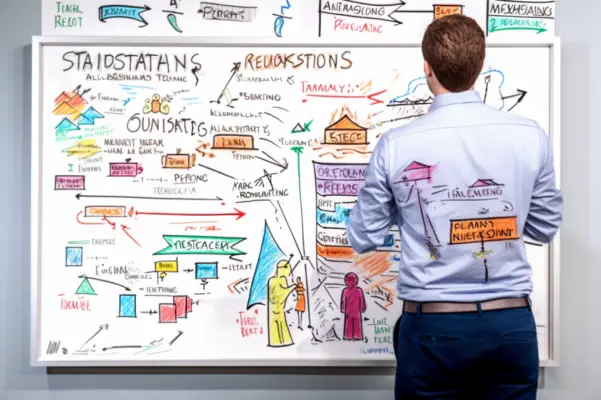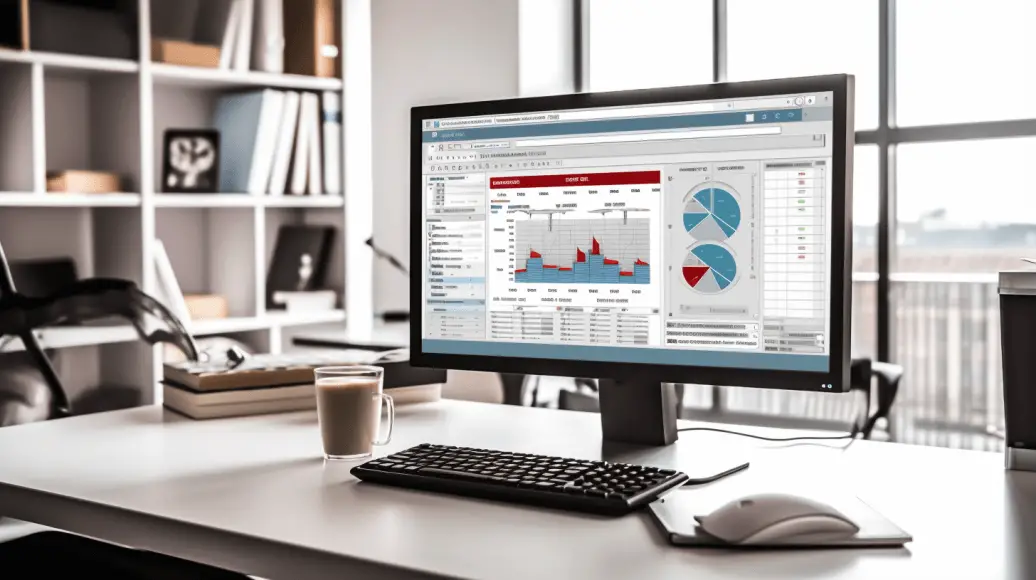This article provides an overview of Risk and Control Self-Assessment (RCSA) in a PDF format.
RCSA is a method used by risk managers to identify, assess, and manage operational risks within an organization.
The article discusses operational risks and their significance in the business environment.
Furthermore, it outlines the process of conducting a thorough RCSA and highlights the requirements for substitute checks in this assessment.

Understanding RCSA Audit
What is Risk and Control Self-Assessment?
Risk and Control Self-Assessment (RCSA) is a proactive approach organizations use to identify, assess, and mitigate risks in their operations.
This process involves the active participation of employees at all levels, allowing them to take ownership of .
The benefits of RCSA include improved risk awareness, enhanced control effectiveness, and increased accountability within the organization.
Benefits of Risk and Control Self-Assessment
One advantage of adopting the practice of risk and control self-assessment (RCSA) is the potential improvement in the overall effectiveness of internal controls within an organization.
This approach allows key stakeholders to systematically identify and evaluate potential and operational risks, leading to better decision-making and risk mitigation strategies.
- Enhanced risk awareness: By conducting regular workshops and testing, organizations can increase employee risk awareness and encourage a proactive approach toward risk management.
- Improved processes: RCSA helps organizations identify inefficiencies and weaknesses in their processes, enabling them to implement necessary improvements and streamline operations.
- Increased accountability: By involving key stakeholders in the assessment process, RCSA promotes a culture of accountability and responsibility for risk management.
- Effective control monitoring: RCSA facilitates the monitoring of control effectiveness, allowing organizations to identify control gaps and implement corrective actions in a timely manner.
Adopting a risk control self assessment re-assessment approach can lead to a more robust and efficient system of internal controls, mitigating potential risks and enhancing organizational performance.
Operational Risks
This focuses on operational risks which arise from an organization’s internal processes, systems, and activities.
There are various operational risks, including technology, legal, compliance, and human resource risks.
When considering potential risk factors, organizations should consider inadequate training, lack of internal controls, and insufficient risk management processes.
Risk and control self-assessment stakeholders include management, internal, and external auditors who work collaboratively to identify and mitigate operational risks.
Types of Operational Risks
Operational risks can be categorized into different types based on their nature and impact on an organization’s operations.
These operational risks are essential to consider during operational risk assessments and the operational risk assessment process.
Identifying and analyzing these material risks, organizations can develop effective risk management practices to mitigate their impact.
The following are three types of operational risks that organizations commonly encounter:
- Risk assessment: This entails identifying and evaluating potential risks that may arise during the execution of operational activities. It involves assessing these risks’ likelihood and potential impact on the organization’s operations.
- Risk control assessments: Once risks are identified, organizations need to assess the effectiveness of existing controls in managing these risks. This involves evaluating the adequacy and efficiency of risk control measures implemented to mitigate operational risks.
- Risk treatment action plans: Organizations can develop plans to address these weaknesses after identifying control weaknesses. This includes implementing control enhancements, process improvements, or other measures to reduce the likelihood or impact of material risks.
Operational Risks
Operational risks are inherent in organizational operations and must be appropriately managed to ensure smooth functioning and mitigate potential negative impacts.
Senior management plays a crucial role in identifying and addressing operational risks within an entity.
They are responsible for establishing a robust control environment and implementing adequate internal controls.
An operational risk manager is often appointed to the operational risk manager to identify, assess, and monitor operational risks.
This individual prepares operational risk reports and recommends measures to make controls adequately address risks and identified weaknesses.
These reports are vital for senior management to make informed decisions and develop a corrective action plan. Financial institutions, in particular, rely quarterly operational risk report very heavily on operational risk management due to the nature of their operations.
Regular audit reports help ensure the effectiveness of the control environment and provide insights into areas that require improvement.
Key PlayersKey ResponsibilitiesKey OutputsSenior ManagementEstablishing control environment,Making informed decisions based on operationalImplementing internal controlsrisk reports and taking appropriate measuresOperational Risk ManagerEvaluating the effectiveness of controlPreparing operational risk reportsMonitoring operational risksRecommending measures to address weaknessesEntityImplementing corrective action plansEnsuring smooth functioning of operationsFinancial InstitutionsEffectively managing operational risksMitigating potential negative impactsEnsuring compliance with regulatory requirementsAudit ReportsEstablishing a controlled environment,Identifying areas that require improvementenvironment
Key players
Potential Risk Factors to Consider
Potential risk factors to consider include:
- The regulatory environment.
- Technological advancements.
- Economic conditions.
- Changes in customer preferences.
These factors can significantly impact an institution’s operations and introduce new risks that must be managed effectively.
To ensure a thorough understanding of these risks, organizations can employ a risk and control self-assessment (RCSA) approach. This approach involves:
- Identifying and assessing risks.
- Evaluating existing controls.
- Determining any gaps or weaknesses in the current risk management framework.
To facilitate this process, organizations can utilize the following key strategies:
- Conduct regular risk assessments to identify potential areas of concern and prioritize corrective actions.
- Implement measures to mitigate residual risks and monitor their effectiveness.
- Establish clear objectives and performance indicators to evaluate the effectiveness of risk management practices.
- Engage external auditors to independently assess the institution’s risk management practices and control environment.
Implementing these strategies, organizations can enhance their ability to identify and address potential risks, improve the quality of risk management practices, and ensure the achievement of their objectives.
Additionally, involving risk owners and staff in the process can help foster a culture of risk awareness and accountability, promoting the adoption of additional and integrating risk management treatments as necessary.
Key Stakeholders in Risk and Control Self-Assessment
Key risk and control self-assessment stakeholders include senior management, internal audit, compliance officers, and all business units and unit leaders.
The responsible officer oversees the process residual risk, and develops suitable action plans to address identified risks.
The process typically involves using structured questionnaires to gather information from various stakeholders.
These questionnaires are designed to assess the organization’s risk environment, risk culture, and risk appetite.
Once the assessments are completed, the stakeholders provide concise feedback on the identified risks and control measures.
This feedback is essential for developing a comprehensive control risk assessment process.
Conducting a Risk and Control Self-Assessment
The process of conducting a risk and control self-assessment involves several key points that contribute to its effectiveness.
These points include:
Assessing the control environment examines an organisation’s overall atmosphere and attitudes towards control.
Understanding internal controls is crucial in identifying the strengths and weaknesses of existing control mechanisms.
Additionally, identifying actual loss experiences helps to assess risks and past incidents’ impact on the organization’s risk profile.
Developing a suitable action plan allows for the implementation of necessary improvements.
Finally, structured questionnaires systematically gather concise feedback from responsible officers, ensuring a comprehensive risk and control assessment.
Assessing the Control Environment
Understanding the organisation’s internal policies and procedures is an important aspect of assessing the control environment.
This involves reviewing the centralised enterprise risk management solution, operational risk management framework, and risk management protocols.
The organization should have clear risk management tools and processes aligned with industry standards.
A top-down risk assessment approach should be implemented, which involves identifying risks in key business processes and assigning key process owners.
The control assessment approach may include facilitated self-assessment, where key stakeholders evaluate the effectiveness of controls within their respective areas.
Additionally, internal audit testing should be conducted to verify control effectiveness independently. By considering these factors, organizations can ensure that their control environment is robust and effective in managing risks.
Understanding Internal Controls
To understand internal controls, organizations must thoroughly examine their internal policies, procedures, and risk management protocols to ensure they align with industry standards and effectively manage operational risks.
Internal controls refer to the systems associated controls, and processes established by an organization to safeguard its assets, ensure the accuracy and reliability of financial reporting, and promote compliance with laws and regulations.
These controls are crucial for achieving organizational objectives and mitigating risks.
An integrated risk management strategy involves implementing risk management capabilities and utilizing risk management platforms to streamline the whole operational risk management process.
As part of this strategy, organizations often utilize a control self-assessment (CSA) entity to assess the effectiveness of their internal controls. CSA involves a bottom-up approach, where individuals within the organization are responsible for evaluating the effectiveness of controls within their respective areas.
This assessment process procedure allows for a more comprehensive evaluation of internal controls and facilitates proactive identification and mitigation of risks.
Various RCSA techniques can be employed, such as surveys, interviews, and documentation reviews.
The internal auditor plays a significant role in reviewing the effectiveness of internal controls and providing recommendations for improvement.
Risk Management CapabilitiesRisk Management Platforms– Incorporate risk management into the organizational culture– Utilize software solutions for risk identification, assessment, and monitoring– Establish risk appetite and tolerance levels– Provide real-time risk reporting and analysis– Implement risk mitigation strategies– Facilitate collaboration and communication among stakeholders– Monitor and evaluate risk management performance– Ensure compliance with regulatory requirements
Identifying Actual Loss Experience
Actual loss experience can be identified by analyzing historical data and examining previous organizational incidents.
This process involves assessing the various external risk factors and exposures that the organization faces and determining the impact of these exposures on actual losses.
Analyzing historical data and incidents, organizations can gain insights into the types of risks they are exposed to and the magnitude of potential losses associated with these risks.
This information is crucial for effective risk management and for determining operational risk capital and allocation.
Dynamic risk management techniques, such as top-down risk assessment and the facilitated self-assessment approach, can be used to identify actual loss experiences.
These approaches involve a range of methodologies, including companywide workshops and disruptive technology, to identify and address document control weaknesses and other risk areas.

Internal Audit Risk Assessment Questionnaire
Developing a Suitable Action Plan
To effectively manage risks identified through the risk and control self-assessment (RCSA) process, developing a suitable action plan is crucial.
This plan should address the identified risks and provide clear steps for mitigating and controlling them.
The action plan should consider the speed of the key risk indicators, such as the likelihood and impact of potential events.
It should also address different types of risks, including counterparty and cyber risks, based on their degree of risk and relevance to the organization.
Developing an effective action plan requires a thorough understanding of the level of risk and the organization’s risk awareness.
Structured Questionnaires for Gathering Concise Feedback from Responsible Officers
Structured questionnaires can gather concise feedback from responsible officers in the risk and control self-assessment (RCSA) process.
This approach offers several advantages, including:
- Efficiency: Structured questionnaires allow for information collection in a systematic and organized manner, ensuring that all relevant areas are covered and reducing the risk of missing critical insights.
- Standardization: By using a standardized questionnaire, the responses obtained from different responsible officers can be easily compared and analyzed. This promotes consistency and enables the identification of common themes and patterns across the organization.
- Comprehensive coverage: Questionnaires can be designed to cover a wide range of risk areas, including geopolitical risks, inherent risks, and strategic-level risks. This comprehensive approach ensures that all levels of risk are considered and addressed in the risk management arsenal.
- Feedback on operating control processes: Structured questionnaires can also provide valuable insights into the effectiveness of operating control processes. By assessing process performance through targeted questions, organizations can identify areas of improvement and implement robust risk management techniques.
Assign Ownership to Individual Risks
Assigning ownership to individual risks is essential in the risk management process. It ensures accountability and facilitates effective monitoring and mitigation strategies.
Organizations can clearly identify who manages a particular risk by assigning ownership.
This accountability holds them responsible for the potential impact of the risk on the business objectives.
Assigning ownership helps in evaluating the effectiveness of risk mitigation strategies. It ensures that the necessary controls are in place to manage the risk effectively.
Assigning ownership also encourages the involvement of relevant staff in discussions during workshops. This allows for the sharing of entity knowledge and expertise.
The outcomes of these workshops can then be used to identify and prioritize popular, respective, and strategic-level risks.
This systematic approach enhances the quality of controls and contributes to the overall risk management framework.
Understand the Speed at which Risks Need to be Addressed
Understanding the speed at which risks must be addressed is crucial in effectively managing strategic-level risks within an organization.
Cconsidering the established objectives and the potential impact of risks on these objectives, stakeholders can prioritize their efforts and allocate resources accordingly.
Real-time technology plays a significant role in this process, as it enables the institution of the organization to monitor and respond to emerging risks in a timely manner.
To ensure the effectiveness of risk mitigation strategies, sufficient testing should be conducted to assess their viability and effectiveness.
Incorporating the following considerations can further enhance risk management efforts:
- Clearly defining timelines for addressing risks.
- Regularly reviewing and updating risk mitigation plans.
- Establishing a feedback loop with stakeholders to ensure ongoing assessment and improvement.
Substitute Check Requirements
Implemented in accordance with the Check Clearing for the 21st Century Act (Check 21), substitute check requirements aim to ensure the legal equivalence of substitute checks to original paper checks.
These requirements apply to respective entities involved in the check-clearing process, such as banks and financial institutions.
These requirements establish standards and guidelines for creating and accepting substitute checks, which are electronic images of original checks.
This ensures that substitute checks are reliable and accurate representations of the original checks, with the same legal rights and obligations.
To ensure compliance with these requirements, various measures are taken.
Organizations may conduct workshops relating to substitute check requirements for their staff, engage external auditors to assess compliance, and actively involve fellow stakeholders to ensure a comprehensive understanding and implementation of these requirements.
Frequently Asked Questions
How Does Risk and Control Self-Assessment (Rcsa) Differ From Traditional Risk Assessment Methods?
Risk and Control Self-Assessment (RCSA) differs from traditional risk assessment methods.
It involves the active participation of employees in identifying and assessing risks and evaluating the effectiveness of internal controls in mitigating those risks.
What Are the Benefits of Conducting a Risk and Control Self-Assessment (Rcsa) for Organizations?
The benefits of conducting a risk and control self-assessment (RCSA) for organizations include improved risk identification.
Also,enhanced control effectiveness, increased accountability, better decision-making, and a proactive approach to risk management.
What Are Some Common Challenges Faced While Conducting a Risk and Control Self-Assessment (Rcsa)?
Common challenges faced while conducting a risk and control self-assessment (RCSA) include lack of stakeholder engagement, limited resources, inadequate training, difficulty defining and assessing risks, and resistance to change.
How Can Organizations Ensure the Objectivity and Accuracy of the Findings From a Risk and Control Self-Assessment (Rcsa)?
Ensuring objectivity and accuracy in the findings of a risk and control self-assessment (RCSA) can be achieved through several measures, such as using standardized methodologies.
It also involves independent parties, conducting regular reviews, and implementing adequate documentation and reporting processes.
Are Any Regulatory Requirements or Industry Standards Govern the Implementation of Risk and Control Self-Assessment (Rcsa) Processes?
Regulatory requirements and industry standards govern the implementation of risk and control self-assessment (RCSA) processes.
These guidelines aim to ensure the effectiveness and reliability of RCSA by providing a framework for organizations to follow in their risk management practices.

How To Write A Risk Management Plan
Conclusion
Risk and Control Self-Assessment (RCSA) is a process organisations use to identify and manage risks proactively assess operational risks. It involves evaluating internal control systems and procedures to ensure risk management effectiveness.
An RCSA involves identifying and prioritizing risks, assessing their potential impact, and implementing mitigating risk control and measures.
By regularly conducting RCSAs, organizations can proactively identify and address potential risks, ultimately improving their risk management practices.
Additionally, organizations may need to comply with substitute check requirements, which involve ensuring the validity and accuracy of substitute checks.
Risk and Control Self-Assessment is a valuable tool for organizations to assess and manage operational risks effectively.

Chris Ekai is a Risk Management expert with over 10 years of experience in the field. He has a Master’s(MSc) degree in Risk Management from University of Portsmouth and is a CPA and Finance professional. He currently works as a Content Manager at Risk Publishing, writing about Enterprise Risk Management, Business Continuity Management and Project Management.

